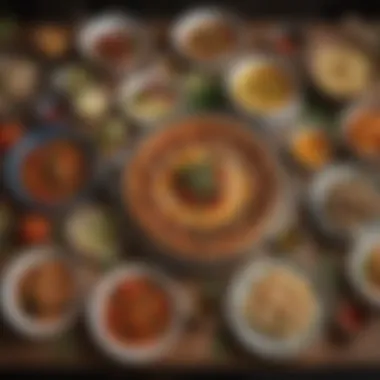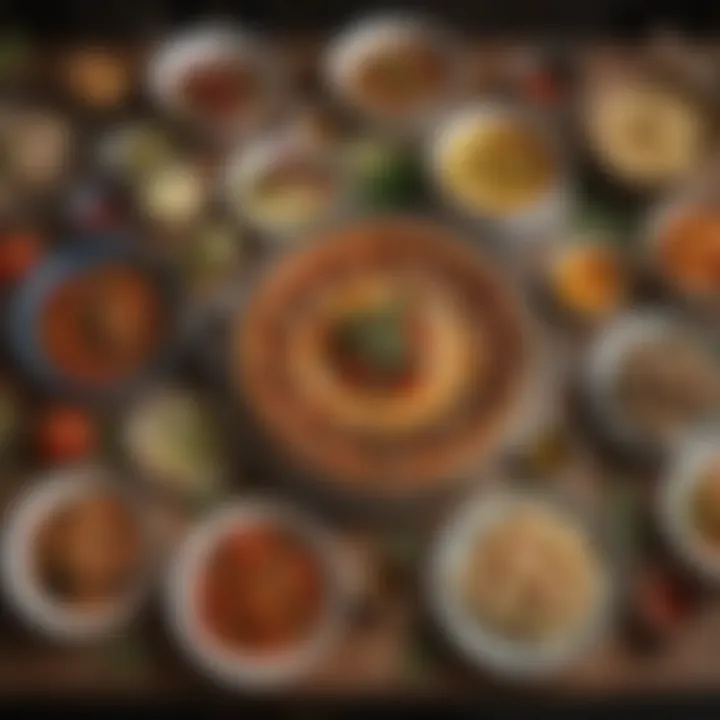Exploring the Heart of a Mediterranean Lunch: Ingredients & Culture


Intro
The Mediterranean region is rich in culture and tradition, and nowhere is this more evident than in its cuisine. A typical Mediterranean lunch transcends mere nutrition, encapsulating fresh ingredients and age-old recipeS. The confluence of flavors not only satiates hunger but also nourishes the soul.
Often, such meals emphasize local produce and communal sharing. In examining this pivotal feature of Mediterranean culture, we can glean not only what foods make up a typical lunch but also understand its broader cultural significance. This article explores essential ingredients, versatile recipes, and the health benefits linked to this approach, offering preliminary help for those who aim to replicate it in their hare in any busy lifestyle.
Recipe Highlight
In this section, we feature a delightful dish known for its vibrant taste and adherence to Mediterranean principles: Chickpea Salad with Feta, Tomatoes, and Olives. This recipe harmoniously merges texture, color, and flavor, ideal for a satisfying lunch.
Essential Ingredients
- 1 can chickpeas, rinsed and drained
- 1 cup cherry tomatoes, halved
- 1/2 cup red onion, diced
- 1/2 cup feta cheese, crumbled
- 1/4 cup Kalamata olives, pitted and sliced
- 2 tablespoons olive oil
- 1 tablespoon red wine vinegar
- Salt and pepper to taste
Estimated Time of Preparation
- Approximately 15 to 20 minutes.
Servings
- Yields about 4 servings.
Step-by-Step Instructions
- In a large bowl, combine the chickpeas, cherry tomatoes, red onion, feta cheese, and Kalamata olives.
- In a small bowl, whisk together olive oil, red wine vinegar, salt, and peppr.
- Drizzle the dressing onto the salad ingredients and toss gently until everything is well mixed.
- Adjust seasoning as necessary and serve.
Insider Advice: Ensure you taste the salad before serving. The freshness varies; some tomatoes might need a bit more salt or acid for balance.
Common Mistake: Avoid over-mixing as this can cause the salad to become mushy.
Variations and Substitutions
- Alternative Ingredients: You could use black beans instead of chickpeas for a different flavor.
- Extra Flavor or Flair: Add some chopped parsley or use lemon zest for umami..
- Pairing Choices: This salad goes well with grilled chicken breast or can be incorporated into a wrap with pita bread.
Time-Saving Cooking Tips
- Preparation: Wash and chop your vegitables beforehand. This helps in effective time management.
- Tools: A sharp kitchen knife and a salad spinner can save valuable time.
- Meal Prep: Create larger portions on the weekends to enjoy during the busy weekday lunch hours.
Nutritional Information
- Calories: Approximately 250–300 calories per serving.
- Key Nutrients: Good source of fiber, good fats, and protein from chickpeas and feta cheese.
- Diet Suitability: This salad is vegetarian and can easily be made vegan by omitting feta.
The Mediterranean diet is recognized for promoting heart health, longevity, and better overall well-being.
Understanding this typical Mediterranean lunch not only enriches mealtime; it encapsulates a sense of community, reflection, and terroir that defines this poignant culinary tradition.
Foreword to Mediterranean Cuisine
Mediterranean cuisine holds a significant place in culinary history and culture. It embodies a vast array of flavors, ingredients, and cooking techniques unique to regions bordering the Mediterranean Sea. Understanding this cuisine is essential to appreciating its impact on daily meals and health. Its importance extends beyond nourishment—it encompasses lifestyle, traditions, and community.
Historical Background
Historical intricacies shape Mediterranean cuisine. For centuries, it has been influenced by various civilizations. Ancient Rome, Greece, and North African populations have left lasting marks on how food is perceived and enjoyed in this area. Trade routes facilitated the exchange of ingredients and ideas. Key staples like olives, grains, and legumes were introduced, accounting for the diet's emphasis on plant-based foods. This fluid history resembles a canvas painted with diverse cultural strokes.
Key Characteristics
The Mediterranean diet is distinctive due to its core components that prioritize fresh, wholesome foods. It values seasonal eating, incorporating local produce into daily meals. Balanced proportions of carbohydrates, proteins, and healthy fats create a meal that feels satisfying yet light. Typical characteristics include:
- High consumption of fruits and vegetables.
- Moderate intake of fish and poultry.
- Low reliance on red meats.
- Extensive use of olive oil, touted for its health properties.
- Use of herbs and spices instead of heavy sauces to enhance flavor.
Emphasizing these components promotes overall well-being, elevating the daily act of eating into an enjoyable, communal practice. Appreciating the significance of Mediterranean cuisine can inspire healthy eating habits worldwide.
Defining a Mediterranean Lunch


Mediterranean lunch is not merely a meal; it embodies a lifestyle that prioritizes fresh, high-quality ingredients with an emphasis on taste and nutrition. It is essential to grasp what constitutes this type of meal in a broader context. Defined by varied compositions, Mediterranean lunches reflect the diverse cultures found in the region—each with specific ingredients and traditions. Understanding this leads to a greater appreciation of not only the food pero its cultural significance.
Typical Meal Structure
A Mediterranean lunch typically unfolds in several distinct yet interconnected phases. This structure may vary based on regional customs, but the core remains. At a Mediterranean table, one usually finds small offerings that engage the appetite, such as dips and bread. Meze platters provide a showcase for a variety of flavors from several dipping sauces like tzatziki and hummus alongside carefully arranged vegetables. Subsequently, signature main dishes, such as grilled fish or roasted meats, often take center stage.
Considerable factors:
- Balance: Unlike quick snacks, a Mediterranean lunch comprises several components that offer a balance of nutrients, keeping someone satisfied without feeling overly stuffed.
- Social Element: This meal encourages sharing and social interaction, typically enjoyed slowly in good company. It is a communal experience, reflecting the character of Mediterranean hospitality.
Regardless of the specific dishes served, the experiences around meals in the Mediterranean tradition emphasize joy, relaxation, and togetherness.
Cultural Variations
Cultural variations greatly influence what constitutes a Mediterranean lunch. Geography plays a remarkable role in defining regional ingredients. Areas like Italy boast pasta dishes while Greece may favor souvlaki and fresh salads.
It is vital to note the environmental contexts contributing to these differences. Seasonal availability of crops heavily influences the menus. Popular elements vary between cooler northern climates and warmer southern areas within the Mediterranean. Despite variations in dishes, one constant remains: freshness.
Key cultural elements include:
- Ingredients : Use of local resources often shapes meal construction.
- Traditions: Traditional cooking methods passed down generations educate flavors and techniques.
- Festivity: Some meals reflect local or religious customs, impacting what specific foods are served and appreciated.
By exploring these facets, one gains insight into a Mediterranean meal's fabric and how it fits within broader societal practices.
Core Components of a Mediterranean Lunch
Understanding the core components of a Mediterranean lunch is essential for grasping the culinary traditions and principles that embody this diet, renowned for its health benefits and cultural uniqueness. Focused heavily on fresh and seasonal produce, the Mediterranean diet relies on a triad of key elements: fresh vegetables, healthy fats, and whole grains. Each plays a vital role not just in flavor but also in nutritional value, making the Mediterranean meal an exceptional choice for anyone seeking a balanced diet.
Fresh Vegetables
Fresh vegetables are simply at the heart of Mediterranean cuisine. They provide essential vitamins, minerals, and fiber. Most importantly, they are used in abundant varieties like tomatoes, bell peppers, cucumbers, and olives. These vegetables contribute not only flavor but also color and texture to meals.
Including a variety of vegetables can be beneficial in numerous ways. They are known for lowering the risk of chronic diseases due to their antioxidant properties. The Mediterranean history shows vegetables being consumed at every meal. This emphasizes their role in everything from salads to stews. Moreover, cooking techniques are simple. Roasting or grilling enhances their flavors; such methods are both health-friendly and time-saving.
Fresh vegetables can significantly boost dietary fiber intake, which supports digestion and overall gut health.
A few examples of how fresh vegetables can be used are:
- Greek salad, rich in cucumbers and tomatoes.
- Ratatouille, combining several veggies in one dish.
- Grilled vegetable platters served with simple dips.
Each of these highlighted dishes showcases how vegetables can shine in various contexts within a Mediterranean lunch.
Healthy Fats
Healthy fats are another cornerstone of this cuisine. They primarily stem from olive oil, nuts, seeds, and certain fish. Among these, olive oil holds a notably esteemed position. This oil not only adds exquisite taste to dishes but also amplifies heart health through its monounsaturated fat content.
The consumption of these fats is linked to reducing inflammation and improving cholesterol levels. Additionally, the practice helps in better absorption of innovative compounds found in vegetables, making meal preparation both effective and health-conscious.
Using these fats in appropriate amounts is key. This could be through drizzling olive oil over salads or employing nuts as toppings for added texture. Some ways to incorporate healthy fats into meals include:
- Dressing vegetables or grains with olive oil for healthy cooking.
- Snacking on almonds or walnuts for nutritious treats.
- Preparing spreads such as hummus that include tahini, thus integrating nuts beneficially.
Whole Grains
Whole grains complete the triad of core components essential in a Mediterranean lunch. They serve as a supportive base in many meals. Foods like farro, quinoa, and whole wheat bread supply crucial fiber and energy. They can also lower the risk of several long-term health issues, including diabetes and heart disease.
Preparation of grains in this cuisine occurs often in very straightforward methods, enhancing ease without compromising nutrition. Mixing them into salads offers a delightful hint of fullness and health benefits. Variabilities can come from simple grain salad recipes using seasonal produce, herbs, and healthy fats. A few valuable ways to stem whole grains into dishes are:
- Serving farro or bulgur in vegetable-based salads.
- Making energy-packed bowls packed with greens, grains, and proteins from other components.
- Loading pita bread with whole grain varieties and bridging them with fresh vegetables and fats for wraps.
In sum, each core component contributes uniquely to flavors and health outcomes. This wholly reinforces the interpretative value of a Mediterranean lunch in terms of nutrition and tradition.
Typical Mediterranean Lunch Dishes
Mediterranean lunch dishes represent not just sustenance, but also a cultural mosaic. Each dish reflects a unique blend of history, geography, and personal heritage. This section will detail the significance of these meals, focusing on their diverse elements, benefits, and considerations that highlight their role in the Mediterranean culinary traditions.
Meze Platters


Meze platters are a quintessential feature of Mediterranean lunches. These small dishes often include a variety of flavors and textures, which invite sharing among friends and family. This concept embodies community and enhances the social aspect of dining.
A typical meze might contain hummus, tzatziki, olives, and roasted peppers. Not only are these ingredients flavorsome, but they also highlight the emphasis on fresh, quality produce that satifies dietary guidelines. Meze promotes slow eating, encouraging diners to savor each bite.
Salads
Salads in Mediterranean lunches go beyond simple greens. They incorporate a kaleidoscope of vibrant vegetables, such as cucumbers, tomatoes, and bell peppers, alongside protein-rich components like chickpeas or feta cheese. The characteristic olive oil dressing lends both depth and health benefits.
The flavor-focused nature of salads means they are rarely boring. Tabbouleh and Greek salad are frequent favorites. These dishes warrant particular attention as they are not only vibrant but also nutrient-dense. The combination of vegetables, healthy fats, and proteins make them essential for anyone pursuing a nutritious diet.
Grilled Meats and Fish
The grilling method is largely predominant in Mediterranean cuisine. Grilled meats, such as lamb, chicken, or tuna, often marinated in herbs and spices prior to cooking. This method produces smoky flavors while retaining moisture. Grilled fish, like sardines or branzino, remains a staple of coastal culinary traditions.
The preparation of grilled dishes comes with considerable health advantages. High in protein and typically cooked with little oil, these meals support muscle maintenance and overall wellness. Additionally, grilling retains vitamin content and enhances the meal with natural aromas.
Pasta and Rice Dishes
Though some may consider pasta exclusively Italian or rice as distinctly Spanish, both ingredients are common across several Mediterranean countries. Dishes such as pasta primavera or paella offer filling yet fresh perspectives on carbohydrates.
Pasta often features in lunch scenarios where lighter sauces are ubiquitous, focusing on fresh vegetables. Rice dishes, on the other hand, frequently encapsulate flavorful stocks, seafood, or meats mixed with saffron.
When prepared thoughtfully, these starches provide essential energy, making lunch not just a pause, but also a time for a recharge.
Mediterranean lunch dishes are about more than food; they represent experiences shared over the table, melding diverse culinary heritages while catering to contemporary health priorities.
As we navigate menus and structures of Mediterranean lunches, it is clear that each dish carries a message and a history. Embracing these meals means not merely enjoying the flavor profile but also appreciating the cultural significance that they offer.
Essential Ingredients to Stock
The significance of having the right ingredients at hand cannot be overstated when discussing a Mediterranean lunch. These components form the backbone of the cuisine, contributing not only to the flavor but also to the nutritional value of the meals. Stocking essential ingredients enhances your cooking experience, making it easier and more enjoyable to prepare traditional Mediterranean dishes.
Olive Oil
Olive oil is a cornerstone of Mediterranean cooking. Its versatility ranges from dressing salads to sautéing vegetables. The flavor profile of good quality olive oil adds significant depth to many dishes. This oil is rich in monounsaturated fats, which are known to support heart health. Additionally, it contains antioxidants like vitamin E and polyphenols, which can help reduce inflammation.
When selecting olive oil, look for extra virgin options, as they are less processed and retain more nutrients. Consider keeping a couple of different types of olive oils in your kitchen for varied flavors. A robust one pairs well with hearty dishes, while a lighter oil can enhance delicate flavors in a salad.
Herbs and Spices
Fresh herbs and spices are vital in Mediterranean cuisine. They do not just add flavor but also offer numerous health benefits. Commonly used items include basil, oregano, rosemary, and thyme. These herbs are used extensively in marinades and dressings, highlighting the natural flavors of vegetables and proteins. Besides taste, herbs serve as sources of essential vitamins, minerals, and antioxidants.
Spices such as cumin, paprika, and saffron enrich dishes with distinct flavor nuances. They can transform a simple meal into an exquisite experience. Including a selection of dried and fresh options can help you customize the flavor profile of your dishes based on personal preference or seasonal availability.
Legumes and Beans
Legumes and beans are indispensable in Mediterranean diets. They are excellent sources of protein, fiber, and important nutrients such as iron. Incorporating these ingredients leads to a hearty lunch that keeps hunger at bay. Common legumes include lentils, chickpeas, and various beans like kidney and black beans.
Cooking techniques for legumes vary, but most can be easily prepared by soaking and simmering. Dishes like hummus or lentil salad exemplify how beans can shine in Mediterranean cuisine. Furthermore, legumes contribute to sustainability in diets, being plant-based sources of nutrition.
In summary, stocking your kitchen with quality olive oil, a diverse range of herbs and spices, and an assortment of legumes and beans facilitates the preparation of authentic Mediterranean lunches. These essential ingredients do more than fill a recipe; they enhance health, flavor, and culinary creativity in everyday cooking.
Health Benefits of Mediterranean Lunch
Exploring the health benefits associated with a Mediterranean lunch is critical for appreciating this diet's overall value. A Mediterranean diet is not just about enjoying flavorful meals; it holds significant advantages for physical and mental wellness. By understanding the nutritional contents and the health impacts, readers can make informed decisions about incorporating these principles into their eating habits.
Nutritional Value
A Mediterranean lunch is filled with various food groups that deliver substantial nutritional benefits. This meal is characterized by an abundance of nutrients derived from fresh vegetables, healthy fats, whole grains, and lean proteins.
- Vitamins and Minerals: Fresh vegetables such as tomatoes, cucumbers, and bell peppers provide a plethora of vitamins. These include Vitamin C, which plays a role in immune function, and potassium, beneficial for heart health.
- Fiber: Whole grains and legumes feature prominently, contributing high levels of dietary fiber. This fiber supports digestive health and maintains stable blood sugar levels. Foods like chickpeas and lentils are particularly rich in fiber.
- Healthy Fats: Olive oil acts as a core ingredient, supplying monounsaturated fats that can help reduce bad cholesterol levels. Unsaturated fats are vital for cardiovascular health.
- Antioxidants: Many Mediterranean dishes include herbs and spices, which are often packed with antioxidants. These compounds can help combat oxidative stress in the body and lower the risk of chronic diseases, such as heart disease and cancer.
By packing nutrient-dense foods into a lunch, individuals can reap these health benefits.


Impact on Overall Health
The Mediterranean lunch model is associated with various long-term health advantages. Here are a few ways this diet contributes positively to overall health:
- Cardiovascular Health: Studies have shown a consistent link between Mediterranean dietary patterns and reduced obstacles to heart health. The inclusion of fruits, vegetables, healthy fats, and whole grains is believed to lower the risk of cardiovascular diseases.
- Weight Management: The nutritional balance found in Mediterranean meals promotes satiety, helping with weight regulation. Non-processed food choices prevent overeating and make it easier to manage body weight without drastic calorie restriction.
- Cognitive Functioning: Emerging research suggests a connection between the Mediterranean diet and improved brain health. Regular consumption of antioxidant-rich foods may delay cognitive decline and safeguard against neurodegenerative disorders.
- Longevity: Adherence to this eating pattern has been linked to greater longevity. Mediterranean populations tend to enjoy higher life expectancy compared to other dietary regimens. The diverse nutrients and overall food quality contribute to greater resilience against age-related health problems.
Adopting Mediterranean lunch principles not only enhances daily meals but also has profound benefits, contributing to healthier lifestyles and longevity.
Overall, understanding Mediterranean lunch's nutritional value and health impacts becomes essential, aiming for a holistic approach to nutrition. Integrating these principles can lead to a remarkable enhancement in both physical and mental health.
Meal Preparation Techniques
Meal preparation techniques are essential for making a Mediterranean lunch both enjoyable and practical. These techniques not only relate to cooking methods but also encompass how to approach ingredient selection and preparation. A thoughtful approach can increase the flavors and authenticity of the meals.
Efficient meal preparation allows for the creation of diverse and healthy dishes. People, often busy with daily life, can benefit greatly from time-efficient methods while still enjoying the fresh taste and health benefits associated with a Mediterranean diet. With the right preparation, creating these satisfying meals can feel easy and inclusive, catering to individual tastes and dietary needs.
Easy Cooking Methods
In Mediterranean cuisine, simplicity rules the kitchen. Minimalist cooking methods aim to preserve the natural tastes of ingredients. This approach allows cooks to highlight the freshness of vegetables, the richness of olive oil, and the meat or fish.
Common easy cooking methods include:
- Grilling: A common technique along coastal regions, grilling enhances the natural flavor of meats and vegetables. Skewers like shish kebabs full of marinated vegetables or grilled fish are delicious and healthy.
- Roasting: Roasting vegetables such as eggplant, peppers, and tomatoes brings out their natural sweetness. For pasta dishes, roasted cherry tomatoes can modify simply a meal into an exquisite experience.
- Steaming: Steamed fish or vegetables preserve nutrients and provide a gentle cooking atmosphere. This method is perfect for fresh ingredients like snap peas or asparagus.
- Sautéing: Using a bit of olive oil, sautéing allows spices to release their aroma while hashing onions or garlic before adding mains like lentils enhances the overall flavor.
By focusing on these techniques, meals become not only more nutritious but also engaging in how they unify different flavors on the plate.
Time-saving Tips
Implementing time-saving tips can significantly help maintain a Mediterranean diet without demanding too much time every day. This mindset embraces both preparation and cooking processes.
A few effective strategies include:
- Batch Cooking: Prepare larger portions of staples such as quinoa or lentils in one go is efficient. These versatile ingredients can feature in different meals throughout the week.
- Prepping Ahead: Chop vegetables in advance and store in airtight containers. This policy ensures they’re ready for quick meal assembly.
- One-pot Meals: Dishes like paella or ratatouille are cooked together in one container, maximizing flavors requiring minimal cleanup afterward.
- Storing Essentials: Keeping a supply of olive oil, herbs, and canned legumes will make for swift meal preparation. These ingredients can unify various dishes quickly and easily.
Incorporating these simple and effective meal preparation techniques can enhance the enjoyment of the Mediterranean diet while simplifying meal creation. When time restraints mount, these methods will ensure the joy spills into combinations of flavors that define Mediterranean lunches.
Incorporating Mediterranean Lunch into Busy Lifestyles
Today's fast-paced life often makes it daunting to prioritize healthy eating patterns, particularly when it comes to lunchtime choices. Incorporating Mediterranean lunch options into busy lifestyles can be a pivotal strategy for maintaining balanced nutrition without compromising flavor. The concept of a Mediterranean meal embraces fresh ingredients, healthy fats, and robust flavors which synergize well with preparation techniques designed for those pressed for time.
The Mediterranean diet has risen popular among health enthusiasts due to its proven benefits. Various studies show that regular consumption of this style of eating can reduce the risk of heart disease, improve cognitive function, and enhance skin health. The key lies in choosing quick-assembly recipes or meals that can be prepared in advance.
Simple Recipes for Quick Prep
For busy individuals who find it tough to spend hours cooking, Mediterranean recipes can be very practical. Here are easy options:
- Greek Salad: Dice cucumbers, tomatoes, and red onions, add olives and chunks of feta cheese. Drizzle with olive oil and sprinkle dried oregano. It takes about 15 minutes and is refreshingly filling.
- Hummus with Vegetables: Combine canned chickpeas, tahini, garlic, lemon juice, and some salt in a food processor. Serve with carrot sticks, cucumbers, or whole grain pitas. This can be made in advance and keeps well in the fridge for several days.
- Quinoa and Tuna Salad: Mix cooked quinoa with canned tuna, diced bell peppers, and a dressing of olive oil, vinegar, salt, and pepper. It’s high in protein and can serve as a meal prep option for the week.
With these straightforward recipes, an individual can have a wholesome, Mediterranean-inspired lunch ready to go in no time.
Make-Ahead Options
Busy schedules increase the appeal of meals that can be made ahead of time. Preparing several Mediterranean lunch entrees in advance spares colossal amount of time during the week. Here are some make-ahead options:
- Mediterranean Grain Bowls: Prepare a base of whole grains like farro or barley. Layer with roasted vegetables, proteins such as chicken or chickpeas, and garnish with herbs. This dish can be stored in individual containers for the week, just adding dressing when serving.
- Stuffed Peppers: Roast bell peppers stuffed with a mixture of cooked rice, beans, spices, and a drizzle of olive oil. Easily reheatable, they provide a hearty lunch choice that is full of flavor.
- Chickpea Stew: A simple chickpea stew made with tomatoes, garlic, and spices can simmer in a slow cooker while you attend to other duties. It stores well and brings soothing warmth on a busy day.
Bringing Mediterranean flavors into daily meals—even under a tight schedule—can lead to nourishment and joy, alleviating stress associated with mealtime while sustaining a healthy lifestyle.
Ultimately, various recipes can be adapted to suit individual preferences, limitations, and available ingredients. Enjoying a Mediterranean lunch does not need extensive culinary skills; it simply requires a desire to embrace healthy, vibrant meals.
Epilogue
The conclusion of this article underscores the vital role that a Mediterranean lunch can play in enhancing both culinary enjoyment and health benefits. As we've delved into the various components that comprise this mealtime, the importance of fresh, wholesome ingredients emerges clearly. The emphasis on vegetables, healthy fats, and whole grains outlines just how these components converge to create not only flavors but also nutritional balance.
Embracing Mediterranean Diet
In adopting a Mediterranean diet, one engages with a lifestyle rather than merely a temporary meal plan. This approach encourages an appreciation for local and seasonal ingredients, which can vary across different regions but consistently centers around fresh produce and sustainable food practices. One should consider exploring local farmers' markets, as they offer a variety of produce that has not lost its nutrients due to long-distance transportation. Furthermore, substituting ingredients is straightforward within this diet, fostering creativity in the kitchen while adhering to the principles of Mediterranean cuisine. Investing time into meal preparation, even in today's busy lives, leads to healthier eating habits and can contribute to improved overall well-being over time.
Final Thoughts
To conclude, understanding the Mediterranean lunch narrative allows for a holistic approach to both eating and health. The integration of ingredients and traditions into our daily lives not only enriches meals but nurtures a sense of community and connection. As we have seen, the balance achieved through diverse food groups provides satisfaction and nourishment. To thoroughly embrace and enjoy these principles, one must remain open to experimenting with flavors and techniques, adapting meals to fit personal preferences and needs. The Mediterranean region showcases an inspiring lifestyle revolving around food that nourishes the body, enhances social bonding, and marks a vibrant connection to cultural roots. By embodying these practices, individuals can gain knowledge and appreciation for a truly enriching culinary experience.







